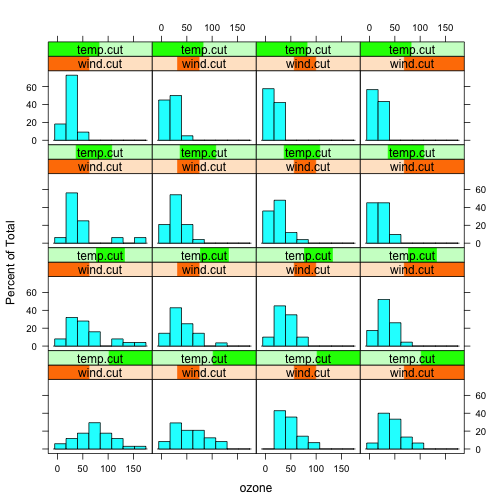The lattice library is useful for quickly making plots of multivariate data. It's easy to make plots which condition on one or more variables.
Load the lattice library
library(lattice)
# Ask for general information about the lattice package
`?`(package, lattice)
# See what is inside of the lattice package. It includes some datasets.
library(help = lattice)
# Load the New York City environmental dataset.
data(environmental)
`?`(environmental)
head(environmental)
## ozone radiation temperature wind
## 1 41 190 67 7.4
## 2 36 118 72 8.0
## 3 12 149 74 12.6
## 4 18 313 62 11.5
## 5 23 299 65 8.6
## 6 19 99 59 13.8
Plot ozone vs. radiation using xyplot
xyplot(ozone ~ radiation, data = environmental, main = "Ozone vs. Radiation")
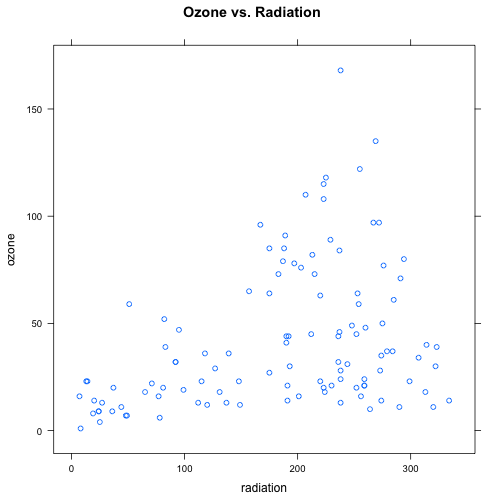
Investigate the relationship between ozone and radiation change as temperature changes
To address this, break temperature into 4 overlapping ranges using the equal.count function.
summary(environmental$temperature)
## Min. 1st Qu. Median Mean 3rd Qu. Max.
## 57.0 71.0 79.0 77.8 84.5 97.0
# Cut the temperature variable into four different ranges.
temp.cut <- equal.count(environmental$temperature, 4)
temp.cut
##
## Data:
## [1] 67 72 74 62 65 59 61 69 66 68 58 64 66 57 68 62 59 73 61 61 67 81 79
## [24] 76 82 90 87 82 77 72 65 73 76 84 85 81 83 83 88 92 92 89 73 81 80 81
## [47] 82 84 87 85 74 86 85 82 86 88 86 83 81 81 81 82 89 90 90 86 82 80 77
## [70] 79 76 78 78 77 72 79 81 86 97 94 96 94 91 92 93 93 87 84 80 78 75 73
## [93] 81 76 77 71 71 78 67 76 68 82 64 71 81 69 63 70 75 76 68
##
## Intervals:
## min max count
## 1 56.5 76.5 46
## 2 67.5 81.5 51
## 3 75.5 86.5 51
## 4 80.5 97.5 51
##
## Overlap between adjacent intervals:
## [1] 27 30 31
# Default layout. This orders panel from left to right, bottom to top.
xyplot(ozone ~ radiation | temp.cut, data = environmental)

# One column layout.
xyplot(ozone ~ radiation | temp.cut, data = environmental, layout = c(1, 4))
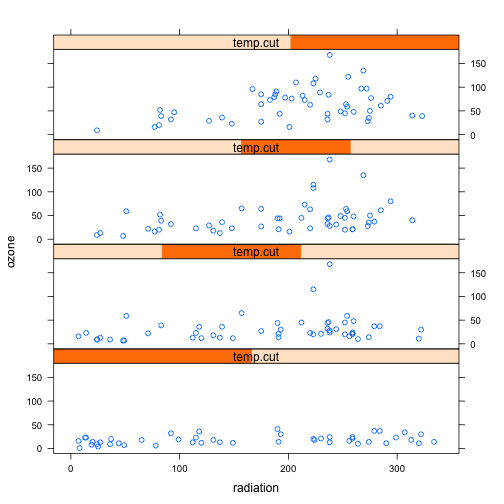
Use the as.table argument to draw panels in order from left to right, top to bottom.
# One column, in ascending order of temperature range.
xyplot(ozone ~ radiation | temp.cut, data = environmental, as.table = TRUE)
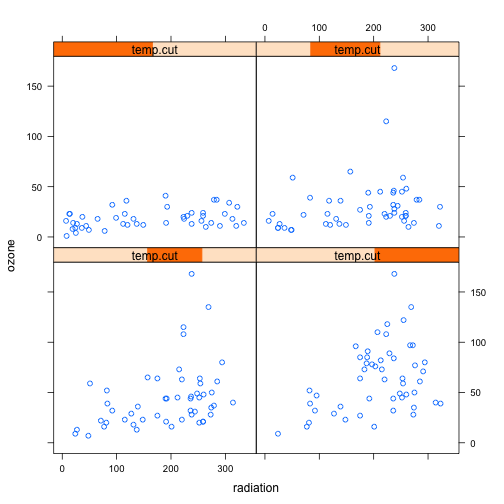
Add a fit to each panel.
Add a fit to each panel using a custom panel function. Note the use of ... which allows for the xyplot parameters such as pch to be passed through the custom panel function.
xyplot(ozone ~ radiation | temp.cut, data = environmental, layout = c(1, 4),
as.table = TRUE, pch = 20, panel = function(x, y, ...) {
panel.xyplot(x, y, ...)
fit <- lm(y ~ x)
panel.abline(fit, lwd = 2)
})
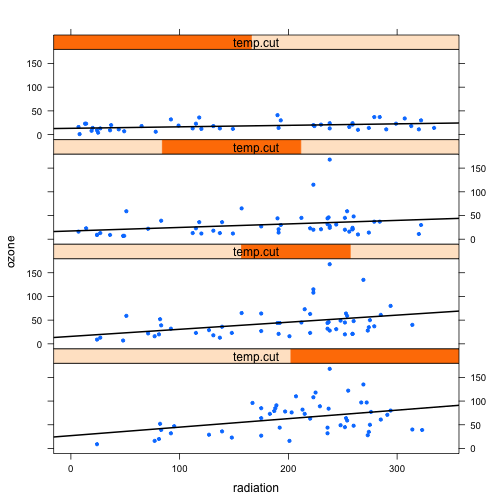
xyplot(ozone ~ radiation | temp.cut, data = environmental, as.table = TRUE,
pch = 20, panel = function(x, y, ...) {
panel.xyplot(x, y, ...)
panel.loess(x, y, lwd = 2)
}, xlab = "Solar Radiation", ylab = "Ozone (ppb)", main = "Ozone vs. Solar Radiation")
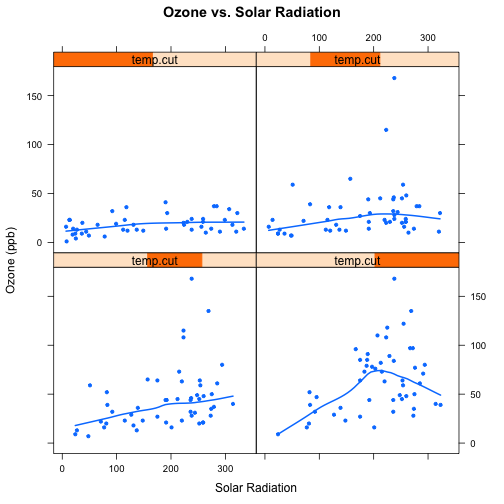
Condition on both wind and temperature.
wind.cut <- equal.count(environmental$wind, 4)
wind.cut
##
## Data:
## [1] 7.4 8.0 12.6 11.5 8.6 13.8 20.1 9.7 9.2 10.9 13.2 11.5 12.0 18.4
## [15] 11.5 9.7 9.7 16.6 9.7 12.0 12.0 14.9 5.7 7.4 9.7 13.8 11.5 8.0
## [29] 14.9 20.7 9.2 11.5 10.3 4.0 9.2 9.2 4.6 10.9 5.1 6.3 5.7 7.4
## [43] 14.3 14.9 14.3 6.9 10.3 6.3 5.1 11.5 6.9 8.6 8.0 8.6 12.0 7.4
## [57] 7.4 7.4 9.2 6.9 13.8 7.4 4.0 10.3 8.0 11.5 11.5 9.7 10.3 6.3
## [71] 7.4 10.9 10.3 15.5 14.3 9.7 3.4 8.0 9.7 2.3 6.3 6.3 6.9 5.1
## [85] 2.8 4.6 7.4 15.5 10.9 10.3 10.9 9.7 14.9 15.5 6.3 10.9 11.5 6.9
## [99] 13.8 10.3 10.3 8.0 12.6 9.2 10.3 10.3 16.6 6.9 14.3 8.0 11.5
##
## Intervals:
## min max count
## 1 2.05 9.45 49
## 2 6.65 10.55 50
## 3 8.95 12.85 47
## 4 10.05 20.95 53
##
## Overlap between adjacent intervals:
## [1] 31 25 32
xyplot(ozone ~ radiation | temp.cut * wind.cut, data = environmental, as.table = TRUE,
pch = 20, panel = function(x, y, ...) {
panel.xyplot(x, y, ...)
panel.loess(x, y)
}, xlab = "Solar Radiation", ylab = "Ozone (ppb)", main = "Ozone vs. Solar Radiation")
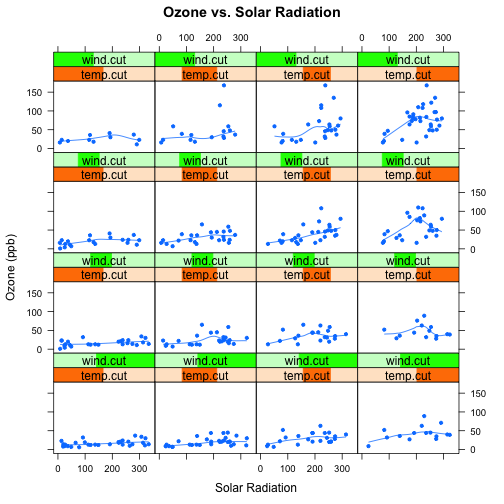
splom
Use splom to draw conditional scatter plot matrices.
splom(~environmental)
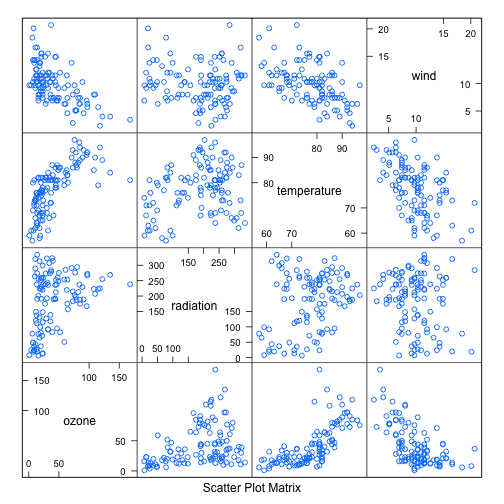
histogram
histogram(~temperature | wind.cut, data = environmental, as.table = TRUE)
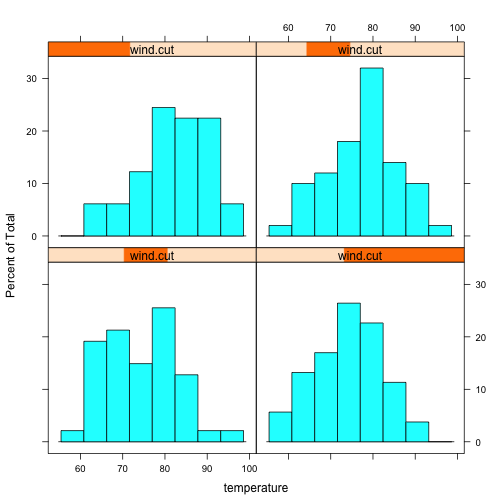
histogram(~ozone | wind.cut, data = environmental, as.table = TRUE)
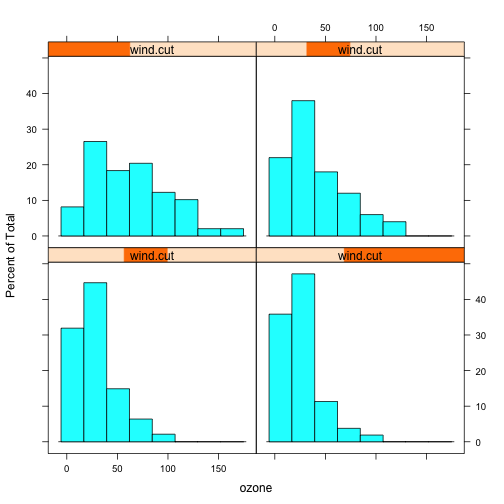
histogram(~ozone | wind.cut * temp.cut, data = environmental, as.table = TRUE)
